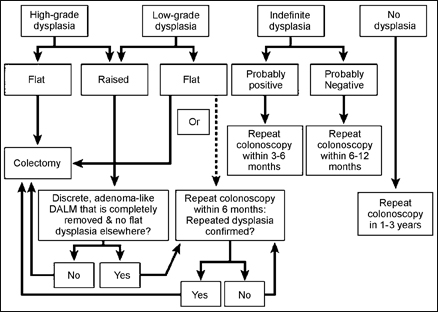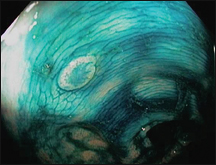Managing CRC Monitoring in Patients with IBD
Q: Which of My Patients with Ulcerative Colitis Need "Surveillance" Colonoscopy? How Should the Procedure be Performed?
A: Patients with long-standing ulcerative colitis are at an increased risk for developing dysplasia and colorectal carcinoma. This risk approaches 8% by 20 years and 18% by 30 years. Recent data suggest that the risk of CRC in patients with UC may be lower than previously reported. Patients with extensive Crohn’s colitis also have an increased risk of CRC and should undergo regular surveillance. At present, despite a lack of evidence from randomized controlled trials, surveillance colonoscopy is the best and most widely used method to detect dysplasia and cancer in inflammatory bowel disease patients. A number of factors are associated with an increased risk of developing CRC in IBD. These include a longer duration of colitis, greater extent of colonic involvement, family history of colorectal cancer, primary sclerosing cholangitis, and severity of inflammation that is defined endoscopically and histologically. Using these clinical factors, patients at an increased risk of developing dysplasia and/or CRC can be identified. Endoscopic findings may also help in the stratification of patients at highest risk of developing dysplasia or cancer. The presence of strictures (OR: 4.62; 95% CI, 1.03-20.8) and pseudopolyps (OR: 2.29; 95% CI, 1.28-4.11) were associated with an increased risk of CRC in one study.
There are several limitations to surveillance colonoscopy, and colonoscopy practices are not uniform. Multiple biopsies are needed, which is time consuming. It has been estimated that 33 biopsies are required to achieve 90% confidence to detect dysplasia if it is present. A recent study demonstrated that dysplasia is more common in the rectum and sigmoid regions compared to the more proximal colon, confirming guidelines that recommend additional biopsies be taken in these areas. The Table is a modification of the American Gastroenterological Association recommendations for the performance of surveillance colonoscopy and management of endoscopic/histologic findings.
The finding of flat, high-grade dysplasia (HGD) confirmed by two gastrointestinal pathologists or carcinoma in endoscopic biopsy samples is an indication for colectomy. The management of low-grade dysplasia (LGD) is more controversial. Strong consideration for colectomy should be given for flat multifocal LGD (more than one colon location) or LGD found on more than one colonoscopy because of the relatively high rate of progression to HGD or cancer.
Dysplasia in IBD may occur in flat mucosa (endoscopically invisible) or as an elevated lesion on endoscopy. In fact, most dysplasia found in patients with IBD is elevated. It is now accepted that endoscopically resectable dysplastic lesions (polypoid dysplasia), also called adenoma-like lesions/masses (ALMs), without associated flat dysplasia surrounding the lesion or elsewhere in the colon may be treated adequately by polypectomy and continued surveillance. In contrast, endoscopically unresectable polypoid dysplastic lesions (nonadenoma-like dysyplasia-associated lesions or masses [DALMs]), remain an indication for colectomy because of their high association with cancer. An approach to the management of dysplastic lesions in IBD, modified from the American Gastroenterological Association, is summarized in Figure 1.

Newer techniques are needed to facilitate the identification of neoplastic lesions in patients with IBD. Chromoendoscopy is the technique most readily applicable in clinical practice. Chromoendoscopy can improve the detection of subtle colonic lesions, raising the sensitivity of the endoscopic examination and improving lesion characterization, increasing the specificity of the examination (Figure 2). In addition, crypt architecture can be categorized using the pit pattern, aiding in differentiation between neoplastic and non-neoplastic changes, and enabling the performance of targeted biopsies. Several different stains have been used, including contrast stains (indigo carmine) and vital stains (methylene blue). These are typically applied using a spray catheter or through a standard water pump attached to the colonoscope. In a recent meta-analysis of six studies involving 1,277 patients, the difference in yield of dysplasia between chromoendoscopy and white light endoscopy was 7% (95% CI, 3.2-11.3) on a per patient analysis with a number needed to treat of 14.3. The difference in proportion of lesions detected by targeted biopsies was 44% (95% CI, 28.6-59.1) and flat lesions was 27% (95% CI, 11.2-41.9) in favor of chromoendoscopy.

Images: Picco MF, Farraye FA

Given these findings, the practice of taking multiple random biopsies of nonpolypoid mucosa (ie, nontargeted biopsies) during UC surveillance has been called into question. Rutter et al found that there was no dysplasia in 2,904 nontargeted biopsies performed. Marion did find three cases (0.09%) of low-grade dysplasia but this was among 3,264 nontargeted random biopsies and prior to chromoendoscopy staining. One of these cases had a dysplastic lesion after dye staining in area of the positive random biopsy. Although random biopsy may find dysplasia, these rates are extremely low, suggesting that random biopsy may be abandoned if chromoendoscopy is performed, but this remains controversial.
Despite convincing data from the literature, chromoendoscopy has not been universally accepted. Although the American Gastroenterological Association and the British Society of Gastroenterology have endorsed the technique, it has not been recommended by the American College of Gastroenterology for general UC surveillance. The American College of Gastroenterology chose not to recommend the technique because of lack of knowledge of the natural history of the lesions detected by chromoendoscopy, but did suggest a possible benefit in high-risk patients (those with a history of dysplasia). Before chromoendoscopy can be accepted widely, further studies are needed to determine its feasibility and to develop quality standards for adopting it into general practice.
Narrow band imaging is a more convenient technique compared with chromoendoscopy and has shown utility in the assessment of Barrett’s metaplasia. Recent studies did not find a benefit in the detection of dysplasia. This may be because of difficulties distinguishing dysplasia from background inflammation with this technique.
Given the inherent difficulties in the performance of surveillance colonoscopy, it has been suggested that chemoprevention be explored as a method to lower the risk of developing dysplasia and CRC in IBD. Chemoprevention refers to the use of drugs to reverse, suppress, or delay the process of carcinogenesis. Several agents have been suggested as chemopreventive, including folic acid, NSAIDs, and 5-aminosalicylic acids. It must be made clear that there is insufficient evidence to modify present screening and surveillance practices in IBD patients taking these medications and that chemoprevention is not a substitute for surveillance colonoscopy.
Excerpted from:
Leung J, Lo SK, eds. Curbside Consultation in Endoscopy: 49 Clinical Questions, Second Edition (pp 75-79) © 2014 SLACK Incorporated.
- References:
- Cairns SR, et al. Gut. 2010;59:666-689.
- Eaden J. Aliment Pharmacol Ther. 2004;20(Suppl 4):24-30.
- Farraye FA, et al. Gastroenterology. 2010:138:738-745.
- Friedman S, et al. Gastroenterology. 2001;120(4):820-826.
- Goldstone R, et al. Inflamm Bowel Dis. 2012;18:832-37.
- Ignjatovic A, et al. Am J Gastroenterol. 2012;107(6):885-90. doi:10.1038/ajg.2012.67
- Kiesslich R, Neurath MF. Gastroenterol Clin North Am. 2012;41(2):291-302.
- Kornbluth A, Sachar DB. Amer J Gastroenterol. 2010;105:501-523.
- Loftus EV. Gastroenterol Clin North Am. 2006;35(3):517-531.
- Marion JF, et al. Amer J Gastroenterol. 2008;103:2342-2349.
- Rubin DT, et al. Gastrointest Endosc. 2007;65(7):998-1004.
- Rutter M, et al. Gastroenterology. 2004;126(2):451-459.
- Rutter MD, et al. Gastrointest Endosc. 2004;60(3):334-339.
- Rutter MD, et al. Gut. 2004;53(12):1813-1816.
- Rutter MD, et al. Gut. 2004;53(2):256-260.
- Subramanian V, et al. Aliment Pharmacol Ther. 2011;33:304-312.
- Subramanian V, Logan RF. Best Pract Res Clin Gastroenterol. 2011;25(4-5):593-606.
- Van den Broek JC, et al. Endoscopy. 2011;43:108-115.
- For more information on the Curbside Consultation in Gastroenterology Series:
- Please visit Healio.com/Books/Gastroenterology.
